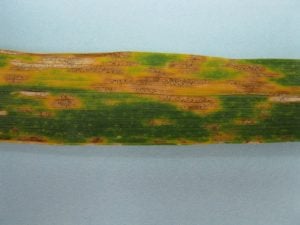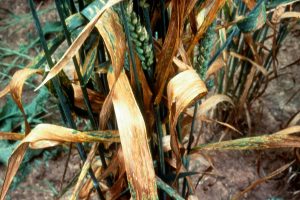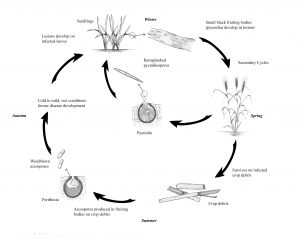Septoria tritici blotch (STB) is an important stubble borne foliar disease of wheat in Victoria. This disease has increased in importance in the high rainfall cropping regions of Victoria since 2012, after well managed in Victoria for the previous 30 years through the use of partially resistant wheat varieties. The increase in STB in the high rainfall zone has been favoured by stubble retention, intensive wheat production, susceptible cultivars and the favourable environment for disease.
When susceptible and very susceptible varieties are grown, septoria tritici blotch is likely to cause annual average losses of up to 20 per cent, with much higher individual crop losses possible.
STB is prone to developing resistance to fungicides. Partial resistance to some triazole (Group 3) and resistance to strobilurin (Group 11) fungicides has been detected in eastern Australia. Therefore, strategies to minimise the further development of resistance is critical in an integrated approach to management.
What to Look For
The fungus causes pale grey to dark brown blotches on the leaves and to a lesser extent stems and heads. The diagnostic feature of septoria tritici blotch is the presence of black fruiting bodies (pycnidia) within the blotches.
These tiny black spots give the blotches a characteristic speckled appearance. When the disease is severe, entire leaves may be affected by disease lesions.
In the absence of the black fruiting bodies, which are visible to the naked eye, similar blotching symptoms may be caused by yellow leaf spot or a nutritional disorder such as aluminium toxicity or zinc deficiency.
The only other disease that has black fruiting bodies within the blotches is septoria nodorum blotch (Parastagonospora nodorum synonyms Stagonospora nodorum, Septoria nodorum), but this disease is rare in Victoria.
Disease Cycle
Septoria tritici blotch, also called septoria leaf spot or speckled leaf blotch of wheat, is caused by the fungus Zymoseptoria tritici (synonym Septoria tritici).
Septoria tritici blotch survives from one season to the next on stubble. Following rain or heavy dew in late autumn and early winter, wind borne spores (ascospores) are released from fruiting bodies (perithecia) embedded in the stubble of previously infected plants. These spores can be spread over large distances.
Early ascospore infections cause blotches on the young leaves. Within these blotches a second type of fruiting body (pycnidia) are produced. Asexual spores ooze from pycnidia when the leaf surface is wet, and spores are dispersed by rain splash to other leaves where they cause new infections. This phase of disease development depends on the rain splash of spores; therefore, septoria tritici blotch will be most severe in seasons with a wet spring. A combination of wind and rain provides the most favourable conditions for spread of this disease within crops.
Septoria Leaf Blotch Management
An integrated approach that incorporates variety selection, cultural practice, crop rotation and fungicides is the most effective way to manage septoria tritici blotch.
Variety Selection
It is important to avoid susceptible and very susceptible varieties, if possible, as they are at greatest risk of yield loss and will also build up inoculum levels across a district, placing increased pressure on moderately susceptible wheat crops. For information on the resistance status of varieties consult a current Victorian Cereal Disease Guide or the NVT website.
Cultural Practice
Avoid planting wheat into paddocks with wheat stubble. If this is not possible, destroying stubble by grazing or cultivation will reduce the number of spores available to infect the new season’s crop. A one- year rotation out of wheat is generally effective to provide a disease break. However, as the fungus may survive for over 18 months on stubble during very dry seasons a two year break is preferred.
Avoiding early sowing can help an emerging crop miss early spore release as a high number of ascospores are usually released early in the season. Where possible plant varieties with more resistance early in the program and leave the susceptible varieties until later in the program and remember that susceptible varieties planted early are at greatest risk from septoria tritici blotch.
Fungicides
Some seed and fertliser applied fungicides can suppress early infection and should be used in areas where septoria tritici blotch is known to occur. Where necessary, effective foliar fungicide sprays are available. However, it is important to correctly identify septoria tritici blotch before spraying with a fungicide as nutritional disorders such as aluminium toxicity or zinc deficiency can be confused with septoria tritici blotch.
In high risk areas, the timing of fungicides will be important to achieve adequate disease control. In early sown, susceptible varieties, a fungicide application at growth stage (GS) 31-32 may be required to suppress the disease and protect emerging leaves. Once the flag leaf has fully emerged at GS39, another fungicide application may be required to protect the upper canopy.
Fungicide Resistance
Fungicide resistance is developing in the septoria tritici blotch pathogen in eastern Australia. Reduced sensitivity to some triazole (Group 3) fungicides was detected many years ago while resistance to strobilurins (Group 11) was detected in 2021. It is therefore important that strategies to minimise the development of fungicide resistance in the Septoria populations are implemented. For further details on fungicide resistance see Fungicides.
Biosecurity
Resistant mutations of the septoria tritici blotch fungus have been identified in other countries, including New Zealand, the United Kingdom and mainland Europe, therefore it will be important for travellers not to accidentally introduce resistant strains of the STB fungus into Australia after returning home from overseas.
Basic biosecurity hygiene for travellers includes washing clothes and cleaning footwear before returning to Australia or leaving clothing and footwear behind if high risk areas have been visited. Remind family members, friends, employees or others travelling to also take these precautions.
Please note: This book is also available on AppleBooks





